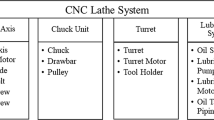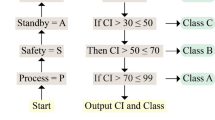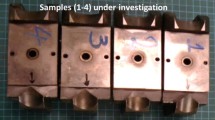Abstract
This work is part of applied research. It aims to apply one of the most commonly used methods in the industries: failure mode, effects, and criticality analysis (FMECA). FMECA is a technique used to identify critical failure modes and thus improve the reliability of the product or components. This paper presents a case study of an FMECA on a Pellegrini 10 T overhead crane newly installed in the compactor assembly workshops of an Algerian company considering the entire process from defining the scope and building the team to the action plan that will reduce the risk priority number (RPN) below the acceptable risk value. The study’s objective is to reduce potential failures of industrial handling equipment by using FMECA, thereby avoiding potential risks and reducing downtime. An application to such an industrial system shows how a company can benefit from this failure analysis methodology.




Similar content being viewed by others
Notes
Based on the results obtained in the FMECA table, we were able to identify the critical organs, monitor them and propose preventive operations to avoid the failure occurrence.
Components with a criticality of less than 12 are considered negligible and do not require design changes but only corrective maintenance. Components with criticality greater than or equal to 12 and less than 16 are considered medium criticality and require an improvement in the performance of the element. In the case of high criticality, which ranges from 15 to 20, the components require a design review and special monitoring. From 20 to 48 the very high criticality considered as forbidden which requires the complete redesign of the component.
The implementation of such a preventive maintenance plan makes it possible to prevent and reduce the interruption of production operations, to maintain the equipment in such a condition that it can operate efficiently and to ensure the quality of the service to be provided or that of the finished product.
References
Huang J, Li ZJ, Liu HC (2017) New approach for failure mode and effect analysis using linguistic distribution assessments and TODIM method. Reliab Eng Syst Saf 167:302–309
Wang W, Liu X, Qin Y, Fu Y (2018) A risk evaluation and prioritization method for FMEA with prospect theory and Choquet integral. Saf Sci 110:152–163
Kumru M, Kumru PY (2013) Fuzzy FMEA application to improve purchasing process in a public hospital. Appl Soft Comput 13(1):721–733 (in English)
Tazi N, Chatelet E, Bouzidi Y (2017) Using a hybrid cost- FMEA analysis for wind turbine reliability analysis. Energies 10(3):276
Selim H, Yunusoglu MG, Yılmaz Balaman SA (2016) Dynamic maintenance planning framework based on fuzzy TOPSIS and FMEA: application in an international food company. Qual Reliab Eng Int 32(3):795–804
Rahimi SA, Jamshidi A, Ait-Kadi D, Ruiz A (2015) Using fuzzy cost-based FMEA, GRA and profitability theory for minimizing failures at a healthcare diagnosis service. Qual Reliab Eng Int 31(4):601–615
Liu HC (2019) Improved FMEA methods for proactive healthcare risk analysis, pp. 15–45, Springer, Singapore
Nguyen TL, Shu MH, Hsu BM (2016) Extended FMEA for sustainable manufacturing: an empirical study in the nonwoven fabrics industry. Sustainability 8(9):939
Brun A, Savino MM (2018) Assessing risk through composite FMEA with pairwise matrix and Markov chains. Int J Qual Reliab Manag 35(9):1709–1733
Bakhtavar E, Yousefi S (2018) Assessment of workplace accident risks in underground collieries by integrating a multigoal cause-and-effect analysis method with MCDM sensitivity analysis. Stoch Env Res Risk Assess 32(12):3317–3332
Peeters JFW, Basten RJI, Tinga T (2018) Improving failure analysis efficiency by combining FTA and FMEA in a recursive manner. Reliab Eng Syst Saf 172:36–44. https://doi.org/10.1016/j.ress.2017.11.02
Wang ZC, Ran Y, Chen YF, Yang X, Zhang GB (2022) Group risk assessment in failure mode and effects analysis using a hybrid probabilistic hesitant fuzzy linguistic MCDM method. Expert Syst Appl. https://doi.org/10.1016/j.eswa.2021.116013
IEC (2001) Analysis techniques for system reliability- procedure for failure mode and effects analysis (FMEA). IEC Standard. IEC-60812. Int. Electrotechnical Commission
MIL (1980) Procedures for performing a failure mode, effects and criticality analysis. Military Standard. MIL- 1629a. US Department of Defense
SAE (2000) Potential failure mode and effects analysis in design (Design FMEA), potential failure mode and effects analysis in manufacturing and assembly processes (Process FMEA). SAE Standard. SAE -J1739. SAE
SAE (2001) Failure modes, efects, and criticality analysisprocedures. SAE Standard. SAE-ARP5580. SAE
Wang X, Zhang Y, Shen G (2016) An improved FMECA for feed system of CNC machining center based on ICR and DEMATEL method. Int J Adv Manuf Technol 83:43–54. https://doi.org/10.1007/s00170-015-7551-y
Kim JH, Jeong HY, Park JS (2009) Development of the FMECA process and analysis methodology for railroad systems. Int J Automot Technol 10:753. https://doi.org/10.1007/s12239-009-0088-z
Plastiras JK (1986) Intersystem common cause analysis of a diesel generator failure. Risk Anal 6(4):463–476
Dale BG, Shaw P (1990) Failure mode and effects analysis in the UK motor industry: a state of- the-art study. Qual Reliab Eng Int 6(3):179–188
Aldridge JR, Taylor J, Dale BG (1991) The application of failure mode and effects analysis at an automotive components manufacturer. Int J Qual Reliab Manag 8(3):111–126
Potente H, Natrop J (1991) Quality assurance of computer controlled hot-tool welding for mass production. Polym Eng Sci 31(7):519–525
Chabane A, Adjerid S, Meddour I (2021) Dependability analysis in systems engineering approach using the FMECA extracted from the SysML and failure modes classification by K-means. Int J Dynam Control. https://doi.org/10.1007/s40435-021-00855-8
Vahdani B, Salimi M, Charkhchian M (2015) A new FMEA method by integrating fuzzy belief structure and TOPSIS to improve risk evaluation process. Int J Adv Manuf Technol 77:357–368. https://doi.org/10.1007/s00170-014-6466-3
Thivel PX, Bultel Y, Delpech F (2008) Risk analysis of a biomass combustion process using MOSAR and FMEA methods. J Hazard Mater 151(1):221–231
Arabian-Hoseynabadi H, Oraee H, Tavner PJ (2010) Failure modes and effects analysis (FMEA) for wind turbines. Int J Electr Power Energy Syst 32(7):817–824
Nazeri A, Naderikia R (2017) A new fuzzy approach to identify the critical risk factors in maintenance management. Int J Adv Manuf Technol 92:3749–3783. https://doi.org/10.1007/s00170-017-0222-4
Salvi RK, Jindal S (2017) FMEA to enhance quality and efficiency of machines: A case study in valve manufacturing industry. Ind Eng J 10(5):13–19
Wu X, Wu J (2021) The risk priority number evaluation of FMEA analysis based on random uncertainty and fuzzy uncertainty. Complexity 2021:8817667. https://doi.org/10.1155/2021/8817667
Zhang X, Li Y, Zhang G et al (2020) An early fault elimination method of computerized numerical control machine tools. Int J Adv Manuf Technol 106:5049–5059. https://doi.org/10.1007/s00170-020-04956-0
Almannai B, Greenough R, Kay J (2008) A decision support tool based on QFD and FMEA for the selection of manufacturing automation technologies. Robot Comput Integr Manuf 24(4):501–507
Bertsche B (2008) Reliability in automotive and mechanical engineering: determination of component and system 860 reliability. Springer Berlin Heidelberg. https://doi.org/10.1007/978-3-540-34282-3
Lee JC, Daraba A, Voidarou C, Rozos G, Enshasy HAE, Varzakas T (2021) Implementation of food safety management systems along with other management tools (HAZOP, FMEA, Ishikawa, Pareto). The case study of listeria monocytogenes and correlation with microbiological criteria. Foods 10:2169. https://doi.org/10.3390/foods10092169
Varzakas TH (2011) Application of ISO 22000, failure mode and effect analysis (FMEA) cause and effect diagrams and pareto in conjunction with HACCP and risk assessment for processing of pastry products. Crit Rev Food Sci Nutr 51:762–782
Trafialek J, Kolanowski W (2014) Application of failure mode and effect analysis (FMEA) for audit of HACCP system. Food Control 44:35–44
Papadopoulos Y, Parker D, Gran C (2004) Automating the failure modes and effects analysis of safety critical systems. In High Assurance Systems Engineering, 2004. Proceedings. Eighth IEEE International Symposium on (pp 310–311). IEEE
Arvanitoyannis IS, Savelides SC (2007) Application of failure mode and effect analysis and cause and effect analysis and Pareto diagram in conjunction with HACCP to a chocolate-producing industry: a case study of tentative GMO detection at pilot plant scale. Int J Food Sci Technol 42(11):1265–1289
Aljazzar H, Fischer M, Grunske L, Kuntz M, Leitner-Fischer F, Leue S (2009) Safety analysis of an airbag system using probabilistic FMEA and probabilistic counterexamples. In Quantitative Evaluation of Systems, 2009. QEST’09. Sixth International Conference on the (pp 299–308). IEEE
Chiozza ML, Ponzetti C (2009) FMEA: a model for reducing medical errors. Clin Chim Acta 404(1):75–78
Kim KO, Zuo MJ (2018) General model for the risk priority number in failure mode and effects analysis. Reliab Eng Syst Saf 169:321–329
Acknowledgements
The authors would like to express their gratitude to all the staff of the Algerian company in charge of the production and marketing of various materials for public works and construction who carried out this research study, headed by the maintenance department staff. Finally, the authors thank the reviewers and the editor for their helpful comments.
Author information
Authors and Affiliations
Contributions
All authors contributed to the study’s conception and design. Material preparation, data collection, and analysis were performed by Rachida Rouabhia-Essalhi, El Hadi Boukrouh, and Youcef Ghemari. The first draft of the manuscript was written by Rachida Rouabhia-Essalhi, and all authors commented on previous versions of the manuscript. All authors read and approved the final manuscript.
Corresponding author
Ethics declarations
Consent for publication
The authors are responsible for the correctness of the statements provided in the manuscript.
Conflict of interest
The authors declare no competing interests.
Additional information
Publisher's Note
Springer Nature remains neutral with regard to jurisdictional claims in published maps and institutional affiliations.
Rights and permissions
About this article
Cite this article
Rouabhia-Essalhi, R., Boukrouh, E.H. & Ghemari, Y. Application of failure mode effect and criticality analysis to industrial handling equipment. Int J Adv Manuf Technol 120, 5269–5280 (2022). https://doi.org/10.1007/s00170-022-09099-y
Received:
Accepted:
Published:
Issue Date:
DOI: https://doi.org/10.1007/s00170-022-09099-y




